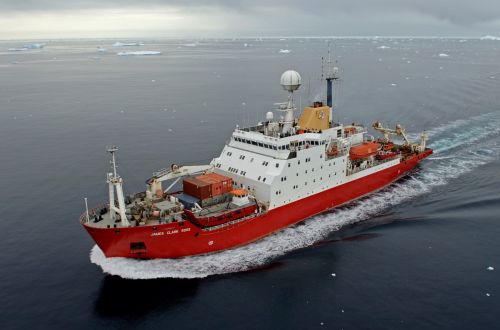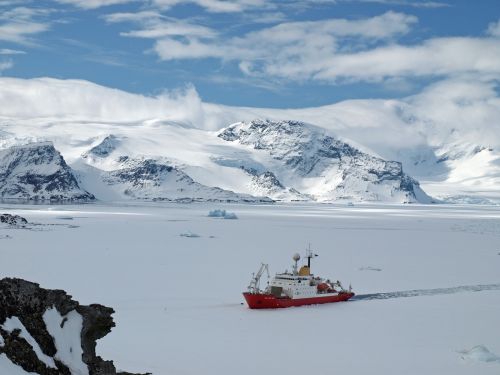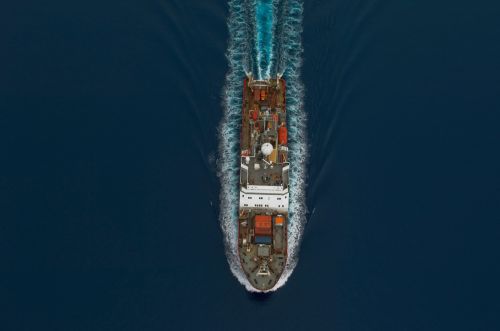In early July this year, the Ukrainian Cabinet of Ministers decided to allocate USD 5 million for the purchase of a research icebreaker vessel for Ukrainian Antarctic expeditions. The James Clark Ross icebreaker, which is almost the same age as independent Ukraine, was acquired from the British Antarctic Survey. It is quite a valuable asset despite its age. It was once one of the three best research vessels in the world and remains one of the top 20.
Having its own icebreaker will allow Ukraine’s Vernadsky Research Base (Academician Vernadsky Antarctic Station) to solve its logistical problems, delivering cargo and expeditions not only during the short Antarctic summer but all year round. However, according to the National Antarctic Scientific Center’s Director Yevhen Dykyi, such an expensive purchase would hardly be justified if it were only intended for improving logistics. The key is that Ukrainian scientists will be able to return to researching the World Ocean after a long break.
In an interview with the CFTS portal, Dykyi explains why the icebreaker was bought only at the second attempt and discusses how the Vernadsky Research Base’s logistics will change and when the first Ukrainian Antarctic expedition will be sent on Ukraine’s own vessel.
Tell us about the story of the purchase of the icebreaker.
We bought this vessel at the second attempt. The first attempt was made in 2019, when it was first announced that the British Antarctic Survey was retiring the James Clark Ross icebreaker from service following the commissioning of a new icebreaker. Then we managed to convince both the Cabinet of Ministers and the Ministry of Education that such a purchase was necessary. The relevant Cabinet of Ministers resolution passed quite easily, but we were unable to secure the approval of the parliament’s budget committee and convince members of the parliament of the need to purchase it. However, it turned out that this was for the best because the British had problems with the commissioning of their new icebreaker and postponed the sale of the James Clark Ross icebreaker for one year.
The second attempt began on 6 February this year, when Ukraine was marking the 25th anniversary of the Vernadsky Research Base. Then, the president of Ukraine spoke directly with members of the expedition at the station for the first time in history and asked them what the state could do to make their work more convenient. The expedition unanimously told him that it wanted its own vessel. After the conversation ended, the president asked me how realistic it was to "get hold of" an icebreaker and added: "Would it be right if we returned to the ocean on our 30th independence anniversary?" Then began the long story about the search for and allocation of funds (the relevant work by the Ministry of Finance and the Ministry of Education and Science, then the adoption of a Cabinet of Ministers directive, and, finally, a positive vote in the parliament’s budget committee) and negotiations between the British and our embassy in London, which eventually ended with the signing of the purchase agreement on 19 August.
How will logistics change following the purchase of the vessel?
The Vernadsky Research Base experienced great logistical difficulties before the purchase of the icebreaker because the station is closed off by floating ice for nine months of the year. Therefore, the entire window of opportunity for replacement of people and delivery of goods for the coming year is essentially during the short Antarctic summer, that is, from January to March. In addition, it is necessary not only to do this during this window, but also to be able to charter a foreign vessel during the window.
We can now maintain the station all year round. This fundamentally changes the situation because there is much less heroism and much more calm work.
We regularly chartered a Russian vessel until 2014. After that, an Argentinean or a Chilean vessel had to be chartered every year. However, it is necessary to understand that demand far exceeds supply in the market of logistics services in Antarctica. Not many vessels are available for commercial charter while more countries are trying to enter Antarctica every year. The number of countries like Ukraine that already have their own polar stations but not their own fleet of vessels for servicing the stations is growing every year and growing much faster than the number of companies that offer vessels for charter. We have often encountered situations in which there were no vessels available during the period that we needed them. Shipowners set their prices accordingly…
Will logistics become cheaper?
I will be able to answer this question in detail when we have worked with our new vessel for one season and I can say exactly how much each vessel day costs us. For now, I can only say that we used to charter vessels for USD 25,000-35,000 per vessel day. We expect that the cost of even a vessel as large as the one that we bought will not be higher than USD 20,000 per day. We will be able to say for sure after the first season of operation.
What other advantages will the Ukrainian polar station gain?
The key difference is that we will no longer be tied to someone else's vessel or this three-month window because the ship we purchased is an icebreaker that is capable of breaking ice that is up to one meter thick in normal operating mode and, if necessary, ice that is three to four meters thick.
This means that we can now maintain the station all year round. This fundamentally changes the situation because there is much less heroism and much more calm work. That is not to mention extreme situations. We had a case in which the life of a member of our expedition who needed an urgent surgical operation was saved only because an icebreaker was stationed at the neighboring Palmer station at that time. Our American counterparts helped us a lot at the time.
With the purchase of this vessel, we have fundamentally different opportunities to perform emergency rescue operations. This applies to personnel at our station and other stations, whom we can help if necessary.
In addition to easing logistics, the vessel conducts research. Can you tell us more?
The fact is that even I, with all my love for the station, would question whether it is worth spending USD 5 million on the purchase of a vessel exclusively to perform a logistics function and then spend an additional couple of million dollars per year on its maintenance. The key point is that this is not just an icebreaker that can travel from point A to point B, bringing people and goods. It is primarily an oceanographic research vessel. It is essentially a floating institute capable of accommodating up to 50 scientists. It has eight laboratories and devices for taking any samples from depths of up to 8 kilometers. That is, almost 90% of the world's ocean floor becomes accessible to our researchers.
It is essentially a floating institute capable of accommodating up to 50 scientists. It has eight laboratories and devices for taking any samples from depths of up to 8 kilometers. This means that almost 90% of the world's ocean floor becomes accessible to our researchers.
This vessel was one of the top three scientific vessels in the world when it was built and it remains one of the top 20 even though 30 years have passed since then.
The main purpose of this investment is not the station’s logistics, although it will change dramatically. The main purpose is to return our science to the ocean. The last oceanic expedition by a Ukrainian scientific research vessel was in 2001-2002. However, starting next year, simultaneously with the work of the Vernadsky Research Base there will be no less work in the ocean, and that is what justifies the purchase of the vessel.
When do you plan its first trip to the Vernadsky Research Base?
We nevertheless acquired a vessel that is 30 years old. Of course, it is currently traveling to Ukraine miraculously under its own power. Moreover, the speed in the North Sea and the Atlantic is 12-14 knots. However, before sending it into a serious icy situation, the first thing we will do when the ship arrives is to order a good refit book. We will obtain documents from the Ship Register and then, depending on the condition of the vessel, we will plan departure for December or January. In any case, we are talking specifically about this year's Antarctic summer. The expedition changeover in March 2022 will definitely be performed with our own vessel.






